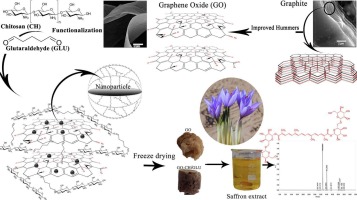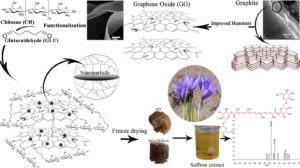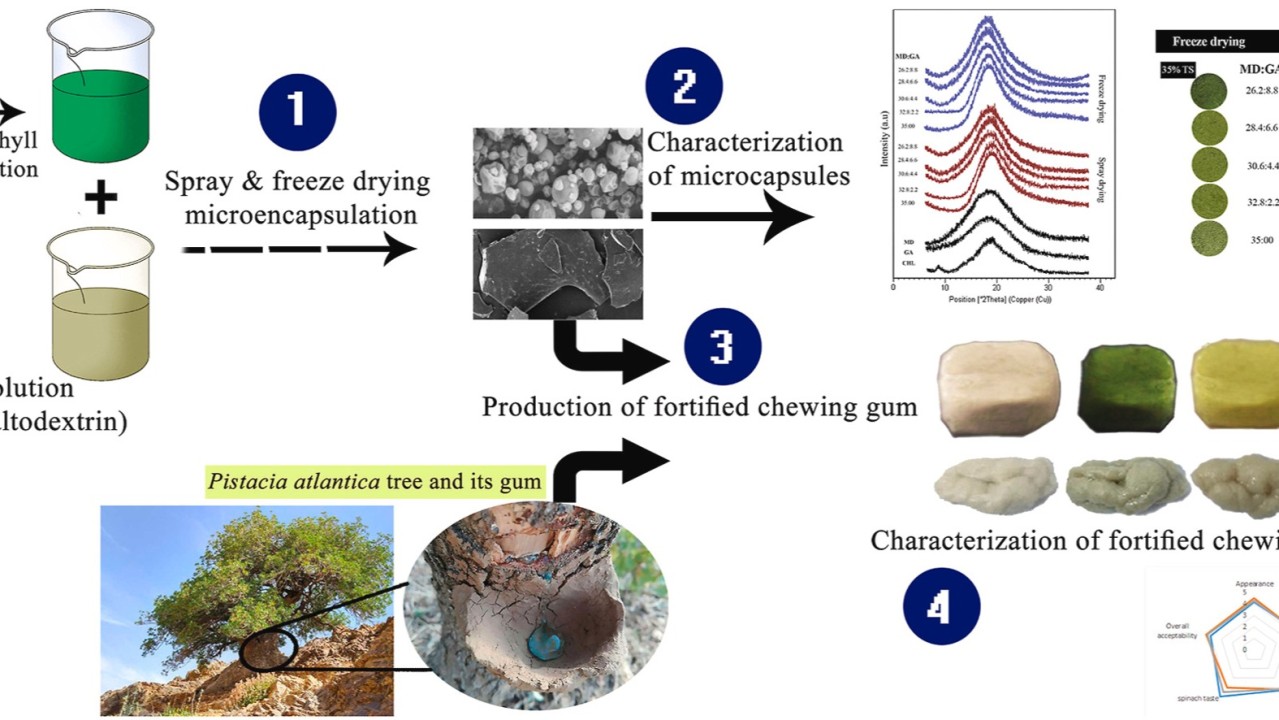By Hamid Rajabi a, Seid Mahdi Jafari a b
- a
- Department of Food Materials and Process Design Engineering, Gorgan University of Agricultural Sciences and Natural Resources, Gorgan, Iran
- b
- Halal Research Center of IRI, Iran Food and Drug Administration, Ministry of Health and Medical Education, Tehran, Iran
Received 26 June 2024, Revised 14 October 2024, Accepted 16 October 2024, Available online 18 October 2024, Version of Record 21 October 2024.
Abstract
Despite the unique properties of graphene oxide (GO) as a green adsorbent, its low structural stability presents a drawback. This study aimed to modify the properties of GO through its functionalization with chitosan (CH), cross-linked with glutaraldehyde (GLU), and synthesized via the freeze-drying method (GO-CH/GLU). Microscopic analysis illustrated that covering the GO sheets with CH and nanoparticles (NPs) resulted in a 15.8 % increase in d-spacing and a 600 % increase in sheet thickness. The GO-CH/GLU composite was utilized for the separation/purification of crocin from saffron extract under varying pH (5–9), temperature (298–318 K), stirring rate (100–300 rpm), and crocin concentration (25–200 mg/mL). The Freundlich isotherm and pseudo-second-order kinetic models provided a good fit for crocin adsorption. Thermodynamic analysis revealed that the process was endothermic, spontaneous, and physical. Optimal adsorption conditions in batch mode were pH 7, a stirring rate of 300 rpm, a temperature of 318 K, and a crocin concentration of 100 mg/mL. These conditions were applied in a continuous system, resulting in a crocin separation efficiency of 94.17 % at 180 mL/h. Additionally, HPLC data indicated that the purity of separated crocin exceeded 90 %. So, the GO-CH/GLU composite is a promising and economical adsorbent for the food industry.
Graphical abstract
Introduction
As society’s awareness increases about the drawbacks of synthetic compounds, the need for natural bioactive compounds has dramatically increased. Saffron, renowned as the most expensive spice in the world, has piqued interest owing to its distinctive attributes as both a culinary and medicinal herb [1,2]. The primary bioactive component of saffron, responsible for its hue and pharmaceutical properties, is a water-soluble carotenoid called ‘crocin’. Numerous endeavors have been undertaken to purify this invaluable compound using both conventional [3] and contemporary techniques [4,5]. However, none of these methods have been successfully commercialized, leaving a clear need for a comprehensive approach.
Nanomaterials (NMS) have an exceptionally high surface-to-volume ratio due to their small size, allowing for more efficient interactions with solutes. Furthermore, the quantum size effects at the nanoscale enhance reactivity, making NMS effective adsorbents [6,7]. Graphene, graphene oxide (GO), and reduced GO are carbon NMS that have garnered popularity due to their favorable and modifiable properties, which adequately fulfill the techno-functional prerequisites of diverse industries [8,9]. Their attributes, such as cost-effectiveness, facile synthesis from inexpensive and accessible raw materials, amenability to structural modification, and expansive surface area, necessitate their development in various fields [10,11]. Specifically, GO possesses an array of functional groups, rendering it an apt candidate for separation processes as its surface can be tailored through functionalization [12,13]. Several researchers have employed these carbon NMS to remove the contaminants such as chromium(VI) [14], methylene blue [15,16], and bisphenol A [17], demonstrating their profound adsorption capacity (ADSC) in separation processes.
Biopolymers are among the compounds used to modify the surface of GO [18,19]. Chitosan (CH) is a biopolymer that possesses distinct types of functional groups, including C2H5NO (or CH3CONH2) and different types of OH groups [20,21]. These functional groups facilitate a multitude of modifications, yielding polymers with novel traits and behaviors [22]. The integration of CH into GO sheets furnishes a framework replete with an array of functional groups, rendering it a formidable, high-capacity adsorbent. A nanocomposite, based on biopolymers, possesses internal pore channels that offer an augmented specific surface area for enhanced adsorption of various compounds, thanks to the plentiful active binding sites available [23,24]. The superior ADSC of these nanocomposites, which makes them highly effective in separating numerous compounds from aqueous environments, can be attributed to their surface chemistry and the existence of a diverse array of functional groups [25,26], including amino, carboxyl, hydroxyl, and epoxy groups. However, the efficacy and mechanical robustness of the resulting nanostructures remain suboptimal.
Glutaraldehyde (GLU), a cross-linking agent, possesses an aldehyde group (-CHO) capable of reacting with various functional groups, which increases the likelihood of successful composite preparation and enhances the mechanical strength of nanocomposites [27]. As such, GLU presents itself as a promising alternative for cross-linking CH and NMs to augment the mechanical fortitude and ADSC of composites for pollutants [28,29]. The conformation of nanocomposites is a salient factor that considerably influences their efficacy in separation processes. While 2D nanocomposites necessitate removal via precipitation through an extended ultrahigh centrifugation procedure, three-dimensional (3D) conformations can be readily separated from the medium through the application of elementary centrifugation [30]. Notably, Rajabi et al. [4] explored GO nanostructures embedded with nanocomplexes of CH and gum Arabic biopolymers to separate crocin from saffron extract (SExt) in batch mode. They introduced a novel adsorbent class for bioactive compounds. However, no documented studies have investigated bio-functionalized nanocomposites (GO-CH/GLU) for isolating crocin from SExt, both in batch and continuous modes.
Given the significant disparities in adsorption conditions between batch and continuous modes and the necessity of this data for process scale-up, the previous study did not investigate these aspects, creating a notable research gap. In this study, GO was synthesized and modified with varying CH concentrations and a fixed GLU quantity, creating a 3D configuration designated as ‘GO-CH/GLU.’ This study aims to bridge this gap by assessing the effectiveness of this novel nanocomposite in crocin isolation, both in batch and continuous systems. The bio-nanocomposites were characterized in terms of morphological-topological properties, crystalline structure, functional groups, surface area, and pore attributes, employing an assortment of techniques. The purity of extracted crocin was evaluated by HPLC at the final stage.
Section snippets
Materials and methods
CH (Mw = 50–190 kDa) and the chemicals used for GO synthesis (graphite powder, hydrogen peroxide, phosphoric acid, sulfuric acid, and potassium permanganate) were obtained from Sigma-Aldrich (USA). The GLU was acquired from Merck (Germany). All remaining reagents used were of analytical grade.
Chemical interactions
Fig. 2A compares the FTIR spectra of CH, GO, GO-CH, and GO-CH/GLU samples. The CH spectra exhibited the presence of several functional groups, including –OH and –NH2 (3439 cm−1), aliphatic C H (2939 and 2895 cm−1), carbonyl (1641 cm−1), −CH2OH group of C6 (1081 cm−1), and − CHROH groups of C3 (1140 cm−1) [33]. As shown in Fig. 2A, the FTIR spectra of GO also displayed several functional groups, including O
H (2939 and 2895 cm−1), carbonyl (1641 cm−1), −CH2OH group of C6 (1081 cm−1), and − CHROH groups of C3 (1140 cm−1) [33]. As shown in Fig. 2A, the FTIR spectra of GO also displayed several functional groups, including O H, C
H, C O, C
O, C C, and C
C, and C O groups, corresponding to the peaks at 3415, 1718, 1628, 1230, and 1054 cm
O groups, corresponding to the peaks at 3415, 1718, 1628, 1230, and 1054 cm
 H (2939 and 2895 cm−1), carbonyl (1641 cm−1), −CH2OH group of C6 (1081 cm−1), and − CHROH groups of C3 (1140 cm−1) [33]. As shown in Fig. 2A, the FTIR spectra of GO also displayed several functional groups, including O
H (2939 and 2895 cm−1), carbonyl (1641 cm−1), −CH2OH group of C6 (1081 cm−1), and − CHROH groups of C3 (1140 cm−1) [33]. As shown in Fig. 2A, the FTIR spectra of GO also displayed several functional groups, including O H, C
H, C O, C
O, C C, and C
C, and C O groups, corresponding to the peaks at 3415, 1718, 1628, 1230, and 1054 cm
O groups, corresponding to the peaks at 3415, 1718, 1628, 1230, and 1054 cmConclusion
This study demonstrated the potential of a GO-based nanocomposite for use in the field of food science through the successful concurrent separation and purification of crocin from SExt. The amalgamation of GH and GLU culminated in the formation of NPs, which were embedded on the surface of GO sheets, exhibiting enhanced technological properties as corroborated by instrumental analyses, including FTIR, XRD, FESEM, TEM, AFM, and BET analysis. The engineered nanocomposite separated >88 % of crocin
CRediT authorship contribution statement
Hamid Rajabi: Writing – original draft, Methodology, Investigation, Data curation. Seid Mahdi Jafari: Writing – review & editing, Visualization, Validation, Supervision, Project administration, Formal analysis, Conceptualization.
Declaration of competing interest
All authors declare that there is no conflict of interest.
References (79)
- H. Rajabi et al.
Retention of saffron bioactive components by spray drying encapsulation using maltodextrin, gum Arabic and gelatin as wall materials
Food Hydrocoll.
(2015) - S.-M. Jafari et al.
Bioactive Ingredients of Saffron: Extraction, Analysis, Applications
(2020) - H. Rajabi et al.
Surface-decorated graphene oxide sheets with nanoparticles of chitosan-Arabic gum for the separation of bioactive compounds: a case study for adsorption of crocin from saffron extract
Int. J. Biol. Macromol.
(2021) - M.S. Samuel et al.
Nanomaterials as adsorbents for As (III) and As (V) removal from water: a review
J. Hazard. Mater.
(2022) - M.S. Samuel et al.
Clean approach for chromium removal in aqueous environments and role of nanomaterials in bioremediation: present research and future perspective
Chemosphere
(2021) - A.T. Smith et al.
Synthesis, properties, and applications of graphene oxide/reduced graphene oxide and their nanocomposites
Nano Mater. Sci.
(2019) - H. Wan et al.
Fabrication and characterization of biomimetic plant cuticles from pullulan-graphene oxide (PU-GO) and beeswax-stearic acid (BW-SA) for citrus Limon Rosso preservation
Int. J. Biol. Macromol.
(2024) - K. González et al.
Effective reinforcement of plasticized starch by the incorporation of graphene, graphene oxide and reduced graphene oxide
Int. J. Biol. Macromol.
(2023) - R.H.M. Ali et al.
An efficient magnetic nanoadsorbent based on functionalized graphene oxide with gellan gum hydrogel embedded with MnFe layered double hydroxide for adsorption of indigo carmine from water
Int. J. Biol. Macromol.
(2023) - M.S. Samuel et al.
A GO-CS@ MOF [Zn (BDC)(DMF)] material for the adsorption of chromium (VI) ions from aqueous solution
Compos. Part B Eng.
(2018) - O. Moradi et al.
Synthesis and characterization agar/GO/ZnO NPs nanocomposite for removal of methylene blue and methyl orange as azo dyes from food industrial effluents
Food Chem. Toxicol.
(2022) - M.S. Samuel et al.
Immobilization of Cu3 (btc) 2 on graphene oxide-chitosan hybrid composite for the adsorption and photocatalytic degradation of methylene blue
J. Photochem. Photobiol. B Biol.
(2020) - O. Moradi
Electrochemical sensors based on carbon nanostructures for the analysis of bisphenol A—A review
Food Chem. Toxicol.
(2022) - H. Rajabi et al.
Preparation and characterization of 3D graphene oxide nanostructures embedded with nanocomplexes of chitosan-gum Arabic biopolymers
Int. J. Biol. Macromol.
(2020) - S. Kamal et al.
Graphene oxide/chitosan composites as novel support to provide high yield and stable formulations of pectinase for industrial applications
Int. J. Biol. Macromol.
(2022) - M.S. Samuel et al.
Adsorption of Pb (II) from aqueous solution using a magnetic chitosan/graphene oxide composite and its toxicity studies
Int. J. Biol. Macromol.
(2018) - I.A.A. Ibrahim et al.
Chitosan biopolymer functionalized with graphene oxide and titanium dioxide with Escin metallic nanocomposites for anticancer potential against colon cancer
Int. J. Biol. Macromol.
(2023) - S. Amiri et al.
Antifouling thin-film nanocomposite NF membrane with polyvinyl alcohol-sodium alginate-graphene oxide nanocomposite hydrogel coated layer for As (III) removal
Chemosphere
(2023) - A.M. Omer et al.
Graphene oxide@ Fe3O4-decorated iota-carrageenan composite for ultra-fast and highly efficient adsorption of lead (II) from water
Int. J. Biol. Macromol.
(2023) - M. Chen et al.
Removal of Pb (II) and V (V) from aqueous solution by glutaraldehyde crosslinked chitosan and nanocomposites
Chemosphere
(2022) - C. Xu et al.
Zr4+ and glutaraldehyde cross-linked polyethyleneimine functionalized chitosan composite: synthesis, characterization, Cr (VI) adsorption performance, mechanism and regeneration
Int. J. Biol. Macromol.
(2023) - C. Qi et al.
Graphene oxide/chitosan sponge as a novel filtering material for the removal of dye from water
J. Colloid Interface Sci.
(2018) - P. Li et al.
Synthesis, characterization, and bactericidal evaluation of chitosan/guanidine functionalized graphene oxide composites
Molecules
(2017) - R. Justin et al.
Characterisation and drug release performance of biodegradable chitosan–graphene oxide nanocomposites
Carbohydr. Polym.
(2014) - D. Han et al.
Preparation of chitosan/graphene oxide composite film with enhanced mechanical strength in the wet state
Carbohydr. Polym.
(2011) - X. Shen et al.
Wrinkling in graphene sheets and graphene oxide papers
Carbon
(2014) - E. Brayfindley et al.
Stone–Wales rearrangements in polycyclic aromatic hydrocarbons: a computational study
J. Org. Chem.
(2015) - O.A. Monteiro et al.
Some studies of crosslinking chitosan–glutaraldehyde interaction in a homogeneous system
Int. J. Biol. Macromol.
(1999) - J. Ahmed et al.
Mechanical, thermal, structural and barrier properties of crab shell chitosan/graphene oxide composite films
Food Hydrocoll.
(2017) - X. Wang et al.
3D self-assembly polyethyleneimine modified graphene oxide hydrogel for the extraction of uranium from aqueous solution
Appl. Surf. Sci.
(2017) - S. Jin et al.
Organic-inorganic building block of phytic acid intercalated graphene oxide for performance enhancement of plant-derived adhesives
Ind. Crop. Prod.
(2023) - J. Ahmed et al.
Morphological, barrier, thermal, and rheological properties of high-pressure treated co-extruded polylactide films and the suitability for food packaging
Food Packag. Shelf Life
(2022) - V.N. Priya et al.
Adsorption of As (V) ions from aqueous solution by carboxymethyl cellulose incorporated layered double hydroxide/reduced graphene oxide nanocomposites: isotherm and kinetic studies
Environmental Technology & Innovation
(2022) - Y. Zheng et al.
Review on nickel-based adsorption materials for Congo red
J. Hazard. Mater.
(2021) - Q. Zhao et al.
Stable graphene oxide/poly (ethyleneimine) 3D aerogel with tunable surface charge for high performance selective removal of ionic dyes from water
Chem. Eng. J.
(2018) - H. Yan et al.
pH-tunable surface charge of chitosan/graphene oxide composite adsorbent for efficient removal of multiple pollutants from water
Chem. Eng. J.
(2016) - M. SefidSiahbandi et al.
Fabrication and implementation of bimetallic Fe/Zn nanoparticles (mole ratio 1: 1) loading on hydroxyethylcellulose–graphene oxide for removal of tetracycline antibiotic from aqueous solution
Chemosphere
(2023) - O. Moradi et al.
Removal of pharmaceuticals (diclofenac and amoxicillin) by maltodextrin/reduced graphene and maltodextrin/reduced graphene/copper oxide nanocomposites
Chemosphere
(2022) - A. Mazinani et al.
Sulfonated calixarene modified poly (methyl methacrylate) nanoparticles: a promising adsorbent for removal of vanadium ions from aqueous media
Chemosphere
(2022)




